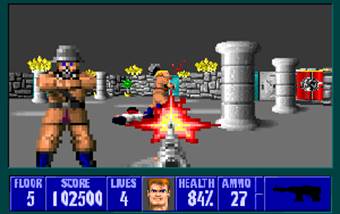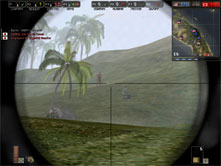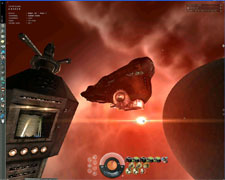After Game Graphics
There was a period of time, perhaps from 1992 to 2006, when it seemed clear what the future of video games would hold: all video games, we believed, would eventually become three-dimensional; their graphics would continue to improve in quality, eventually reaching the point where video games would be photorealistic, indistinguishable from the real world. This, we now know, is not the only future of video games.
There were, however, perfectly good reasons for the interest in graphics. From the early 1990s, games like Wolfenstein 3d suggested that three dimensions would be the future of video games, and console manufacturers like Nintendo, Sega and Sony were quick to promote their new game machines on the basis of their 3d capabilities. In fact, Nintendo 64 was promoted with the promise of graphics ‘like Jurassic Park’. For the launch of PlayStation 2, Sony similarly told potential buyers to ‘imagine walking into the screen and experiencing a movie in real-time’. When launching Xbox 360, Microsoft promised us that we were entering the ‘HD era’, an era of high definition graphics. The Nordic game and the demo scene
Enter video games from the Nordic countries. Few Nordic video games are obviously Nordic. There are no references to the welfare state, few to Vikings or Norse Mythology. No pale colours, no Hammershøj, Munch or Zorn references, no Strindberg, Laxness, Ibsen or Kierkegaard. No Kaurismäki, no Tove Jansson or Astrid Lindgren. Looking at high-profile Nordic games like Hitman, Max Payne, Eve Online, Age of Conan, Chronicles of Riddick or Battlefield ... what do they even have in common? Some are innovative; some are solid variations on well-known genres. Is there a shared visual style of these games? Probably not. What these games have in common is not a single visual style, but a focus on process, on using technological innovation to create new styles and forms of expression. Many Nordic video games grew out of the demo scene. Since the late 1980s, the Nordic countries have been known for a thriving underground milieu of programmers, graphics artists and musicians who meet and compete on demonstrating their technical prowess by creating short programs known as demos. Demos are small programs that serve no function other than to show off the skill of the demo makers. (The author used to program demos on the Commodore 64.) The demo scene is a competitive environment where programmers battle to create the fastest algorithm, the cleverest innovation and the newest flashy graphical effect. The most prominent ‘Nordic’ characteristic of this subculture may be the fact that no money is involved: all effort is spent on gaining recognition from peers. Several Nordic game developers started out by getting involved in the demo scene. With this as background, the Nordic style could be said to focus on extending the technical reach of the platform one is working on. To work with technology is sometimes erroneously presented as being in opposition to creativity, but developing and using technology is no different than, say, designing a new musical instrument and writing music for it. Creating a new technical solution to a problem opens for new possibilities, and the challenge is then to create a game that exploits these possibilities. What characterizes the Nordic style, then, is the focus on this newness, on using technological innovation to create new games and experiences. The invisible core of video gamesI said that the future of video games does not lie simply with increased graphical quality. One mundane reason for this is that advances in graphical technology have historically lead to increases in game budgets, with the average budget for a new video game doubling with each console generation. At the time of writing, the most expensive games have development costs of around 100 million US dollars. This trend of growing budgets must break at some point, and this point is now. Sure, graphics technology continues to improve, but video game history has taken a left turn. The most popular game console today, the Nintendo Wii, has graphics that are technically lower in quality than those of its two competing consoles, PlayStation 3 and Xbox 360. Graphics still matter, but players do not buy the Wii because of improved graphics, they buy it because it has games they want to play. As of 2009, video games are played by more than 50% of the population in many Western countries. For many in this broad audience, the graphics do not need to be photorealistic at all. People happily play simplistic puzzle games on their mobile phones and web browsers. Music games with obviously fake plastic instruments are among the most popular games in recent years. Why are video games turning away from photorealism? Think about the compound term video games. As it suggests, video games are fundamentally a visual art form since they involve video. But video games are also a type of games, and it is their invisible part, their rules, that make them video games. To play games is an ancient human pastime that can be traced across thousands of years and to just about every human culture. Games predate cinema, television and print literature by thousands of years. Most people understand what a game is. Therefore, the way to reach the broadest possible audience is not to make technically amazing graphics, but to make something that fits with the audience’s understanding of what a game is. For example: simple puzzle games, tennis games, music games. Seen this way, the Nordic video games that I have described are at odds with what I call The Casual Revolution. To explain, the last few years have seen a major shift away from big-budget titles, away from focus on graphical quality, away from long intensive games, towards games that can be picked up easily and played in short bursts or as the player desires. This is a new wave of games with a smaller scope. Where does this leave Nordic video games? The other Nordic game: the future
There is another type of Nordic video game that responds to the challenge presented above, of creating games that exploit the possibilities new technical solutions allow. This type of game also grows from the demo scene, but in a different way; participants of the demo scene contribute for the love of contributing, for the love of creating new things, for the love of experimentation. The works of developers like Swedish Cactus and Finnish Petri Purho show an entirely different way to create a Nordic video game. It is still technical, still an experimentation with new expressions, but in a smaller format, in a hand-drawn or lo-fi graphical style. Drawing objects that come to life in Crayon Physics, or playing with low resolution vector graphics in the works of Cactus, are also shaping the future of video games. While these games do not attempt the shiny graphical polish of the Hitman or Battlefield series, neither are they nostalgic returns to the earlier history of video games. They are re-imaginings of what can be done with video game technology, and re-imaginings of what a video game can even be. It is now clear that the future of video games lies not in following a single well-defined trajectory. Some games may require hundreds of hours to play, while others may be over in a hundred seconds. Some will have amazingly graphics, the equivalent of an effect-heavy Hollywood blockbuster. Others will be hand drawn and experimental. The future of video games is not simply about creating technically better graphics, but about experiments and innovations, about creating games in different shapes and sizes. Literature:
|





